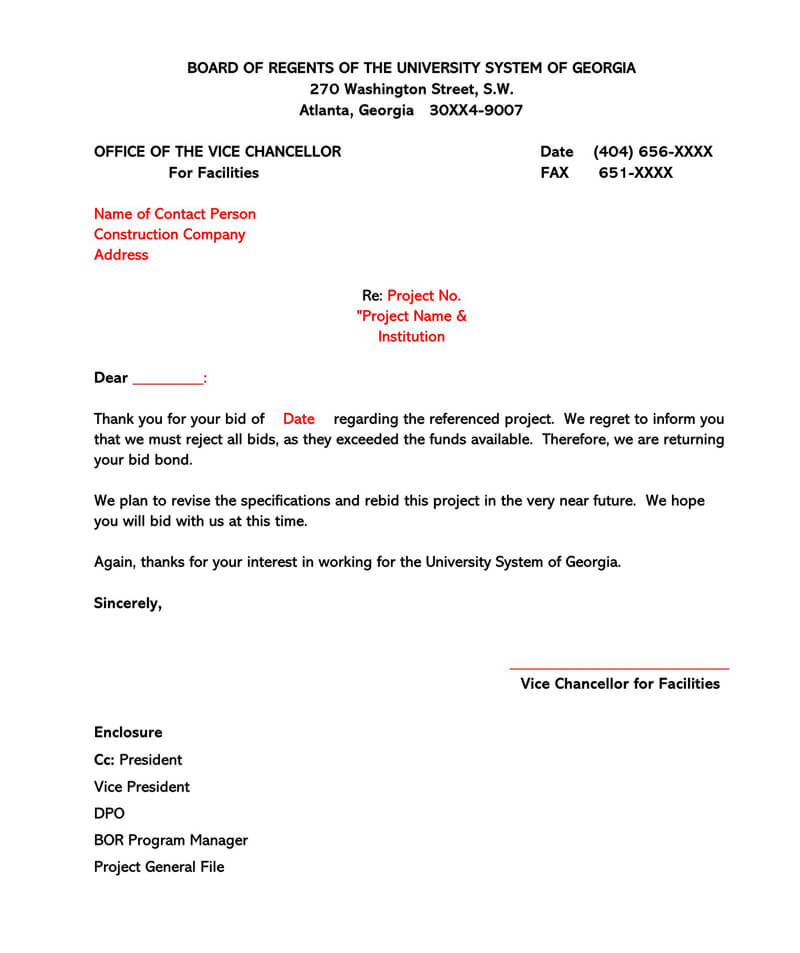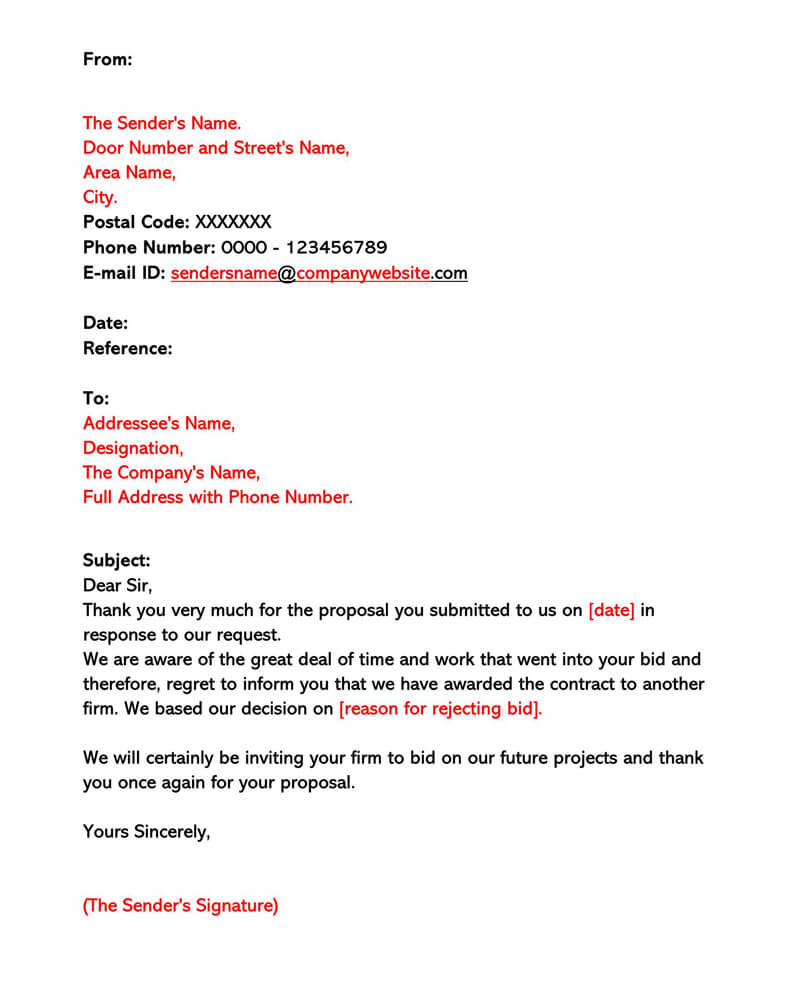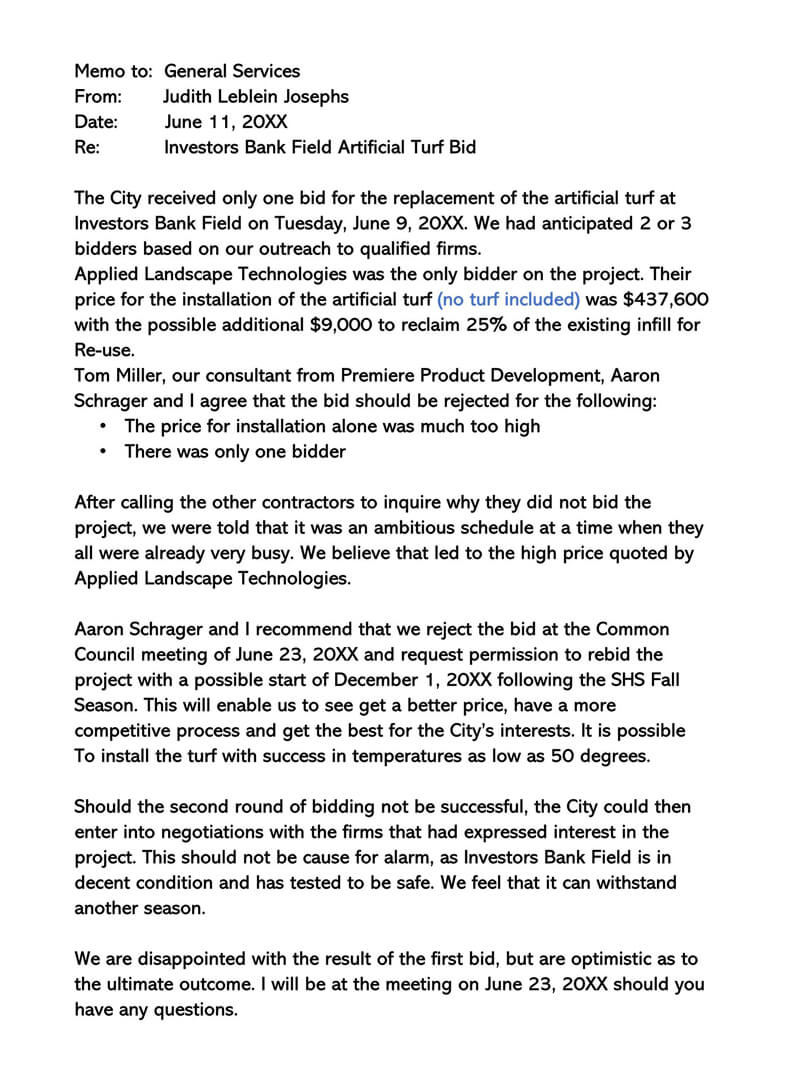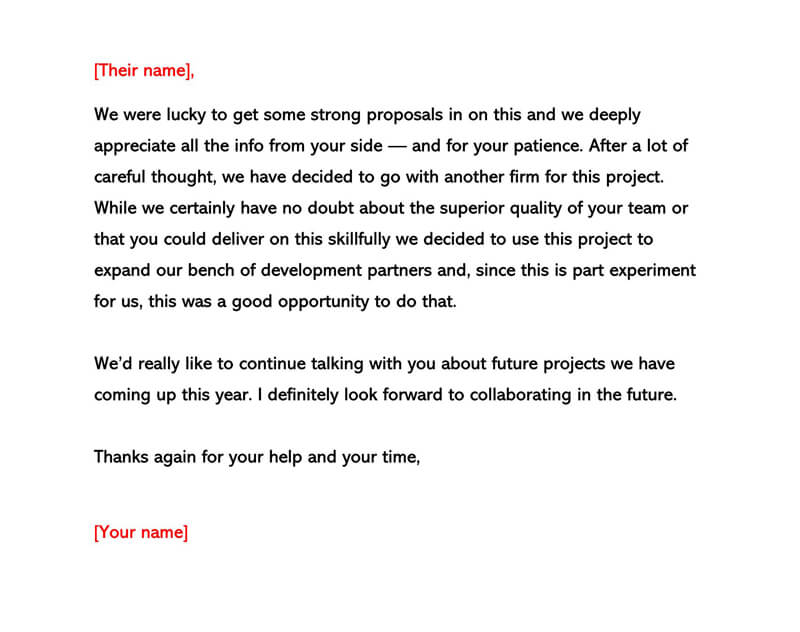A bid proposal is to an organization what a job application is to a job-seeker. It is basically a formal document that one business (otherwise called a contractor) sends out to another business in response to an earlier request for a proposal.
In its basic form, it contains a detailed plan as well as proposed costs which the company aims to rely on to execute the tasks if accepted. Some proposals may also contain other terms of reference, which the business shall uphold while executing the tasks if picked.
Bid Proposal Rejection Letter Templates




5 Common Reasons for Proposal Rejection
It is not always that a bid proposal is accepted. Indeed, many are turned down than are accepted.
The following are the main reasons underlying this:
Exorbitant pricing
Most proposals are often pricier than the range of price which the company inviting the bids is comfortable with. Definitely, each company wishes to spend the least realistic amount of money on any project. That is why they prefer the cheapest quote.
Improper schedule
Apart from pricing, most companies will want their tasks to be completed within certain timeframes. It would normally be that those who send out bids are simply unable to complete the tasks within the stipulated timeframes.
Lack of necessary expertise
For any task to be done to perfection, the person or company doing it has to possess the necessary technical expertise. In many cases, the companies submitting the bids lack part or whole of the expertise required.
Inadequate experience
Possessing the necessary technical expertise in and of itself is never enough. It is also mandatory that the company submitting a proposal also possesses some experience. A proposal may hence get rejected if there is insufficient experience.
Poor operational model
Lastly, most companies prefer working with one contractor. These days, it is not uncommon for companies to subcontract their tasks to third parties or freelancers. Yet again, the companies submitting the proposals may be rejected by virtue of a poor operational model.
How do I write?
Drafting a regret letter, especially to a trusted company, is never that easy. However, you have to do it. While at it, be sure that you maintain some courtesy. Rejecting a bid should not be the end of your relationship with that company at all.
Start off by thanking the company. State the project in reference and the date. Needless to say, you have to draft this letter on your official company letterhead.
The general rules for drafting an official letter apply. Write the date at the top of the script. Include the name and address of the company. Use the block writing style. Alight all text to the left-hand side of the page.
Single-space the contents while including some double spaces in between two successive paragraphs. Unless specified, use the ‘Times New Roman font, as it is the one most commonly used for official letters. Lastly, address the recipient using official terms like ‘Dear Mr. Duncan.’
What should be the tone?
The tone has to be professional and courteous. Avoid using slang or other derogatory terms in your discourse. Remember, rejecting this particular bid may not necessarily mean the end of your association with this company.
Further, find something positive about the company in question and point it out.
EXAMPLE
You may say, ‘We admire your consistency in providing outdoor catering services.’ Next, complement the contractor on their proposal, previous tasks, or general reputation.
How do I decline the proposal?
Now to the crux of the letter. Reject the bid. While at it, get straight to the point. Do not use too many words to drive your point home. Follow this with a candid explanation as to why you inevitably had to reject it.
Alternatively, you may also point out a mistake or issue with the proposal that led to its rejection. This will help the contractor prepare well for future proposals. It will also go a long way in dispelling any ambiguities that the contractor might have.
Encourage future submission
Now encourage the contractor to be on the lookout for future opportunities. Assure them that this rejection will not in any way compromise their future bids.
If you have a number of ongoing projects at the same time, make it clear to the contractor that it is this particular bid that you have rejected. They will still be considered fairly and squarely for the pending ones.
How do I close the letter?
Now close the letter by stating that you look forward to working with them again in the future. Tell them the sources of information where they may most likely obtain the information if and when the time comes.
Conclude the letter appropriately by using courteous terms like ‘Sincerely,’ ‘Regards,’ ‘Faithfully’ or ‘Yours Truly.’ These terms show some personal touches, which go a long way in cementing the bonds that already exist between you two.
Things to Include and Avoid in Your Letter
While drafting such a letter, there are things you must incorporate in the letter and those you may choose to ignore. In this segment, we are going to look into both of them.
Should Include
- Date: A date, by all means, has to be in this letter. It is useful for future reference and for accurate record-keeping.
- Salutation: While addressing the recipient, you have to be formal and official. This can only happen if you include the necessary salutation. Examples are ‘Dear,’ ‘Sir,’ and ‘Mr.’
- Body: The body section is the most important part. That is because it contains the finer details of the rejection. It is, as a matter of fact, the bulk of the letter.
- Signature: Lastly, you have to incorporate the signature in your letter. The signature yet again goes to enhance the official character of this letter. It gives the letter some credence and authority.
Should not include
- Reference: Whereas the reference is used in other official letters, it is not really necessary in a rejection letter. Simply ignore it and get straight to the body section.
- Disparaging Comments: As stated severally earlier, rejecting a bid need not necessarily signal the end of your association with the affected contractor or company. This is why you desperately want to stay away from any disparaging comments.
Sample Bid Proposal Rejection Letter
A model bid proposal rejection letter is presented here, providing you with a valuable example to assist you in navigating the delicate process of communicating bid refusals courteously and respectfully.
sample
Dear Mr. Anderson,
I trust this letter finds you in good health and high spirits. We appreciate the time and effort you invested in submitting your bid for “Project XYZ” to SmithTech Solutions Inc. Your proposal was carefully reviewed and evaluated by our team, and I would like to express our gratitude for your interest in partnering with us on this project.
After a thorough assessment of all the received proposals, we have decided on the selection of the successful bidder. Regrettably, we must inform you that your bid for “Project XYZ” has not been selected for acceptance at this time. While your proposal demonstrated several commendable qualities, we ultimately opted for an alternative proposal that aligns more closely with our project requirements and objectives.
We understand the time and resources that go into preparing a bid, and we genuinely appreciate your commitment to our project. We encourage you to continue pursuing opportunities with our organization in the future, as we believe that TechPro Innovations Ltd. has the potential to be a valuable partner.
Once again, thank you for your participation in the bidding process for “Project XYZ.” We wish you the best in your future endeavors, and we look forward to the possibility of working together on upcoming projects.
If you have any questions or require further feedback regarding the evaluation of your proposal, please feel free to contact our procurement team at procurement@smithtechsolutions.com or (555) 123-4567.
Sincerely,
John Smith
[Signature]
[Enclosure: Summary of Bid Evaluation]
[CC: Procurement Team]
Key takeaways
Here are the key aspects that make this letter a useful guide for someone learning to write a similar rejection letter:
- The letter begins on a polite and empathetic note by expressing concern for the recipient’s well-being, setting a positive tone for the message.
- It effectively acknowledges the effort and time the bidder invested in submitting their proposal, displaying respect for their commitment.
- Transparency and gratitude are prominent throughout the letter. It explicitly states that the proposal was reviewed and appreciated, fostering open communication.
- The letter provides a clear reason for the rejection without delving into excessive detail, explaining that an alternative proposal is better aligned with project requirements.
- Encouragement for future opportunities is offered, maintaining a positive outlook and leaving room for potential collaboration down the line.
- The appreciation for the bidder’s commitment and interest in the project is reiterated, ensuring that their efforts are acknowledged.
- Contact information for further communication is provided, demonstrating the organization’s willingness to be transparent and responsive.
- The closing of the letter is formal and professional, including the sender’s full name and signature.
- Optional elements, such as enclosures (e.g., summary of bid evaluation) and CC (carbon copy) for the procurement team, are included, which can be helpful for additional information and documentation.












